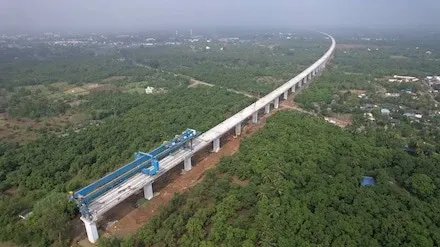The construction of a significant 60-metre-long steel bridge in Vadodara, Gujarat, marks a major milestone in the Mumbai-Ahmedabad High-Speed Rail (MAHSR) corridor. Built under the ‘Make in India’ initiative, this is the fifth completed steel bridge of the planned 28 for the corridor, supporting the Western Railways’ Bajwa-Chhayapuri line. Developed by the National High-Speed Rail Corporation (NHSRC), the bridge showcases India’s engineering capabilities while incorporating Japanese technology.

Impressive Engineering and Design
The Vadodara bridge, weighing approximately 645 metric tonnes, stands 12.5 metres high and spans 14.7 metres in width. Manufactured in Bhachau, Kachchh, the structure was transported to Vadodara for installation. Built to last a century, the bridge features elastomeric bearings and uses 25,659 high-strength bolts with C5-grade painting for durability.
Complex Assembly and Installation
The bridge was first assembled on a temporary ground base before being lifted to a height of 23.5 metres using two semi-automatic jacks with 250-tonne capacity each. MAC-alloy bars were employed in the elevation process, making the task both precise and efficient.

Fast Travel Times and High Frequency
Once completed, the MAHSR will connect Mumbai and Ahmedabad in a little over two hours, with trains reaching speeds of 320 km per hour. The corridor will operate 35 trains daily, running every 20 minutes during peak hours and every 30 minutes during off-peak times. The operations control room for the corridor is set to be located in Sabarmati.
This project, while leveraging Japanese expertise, heavily relies on Indian technology and materials, reinforcing India’s infrastructure development under the ‘Make in India’ initiative.
